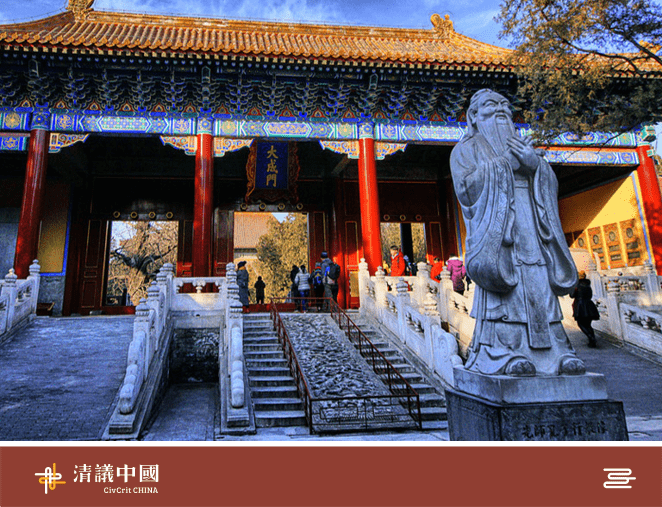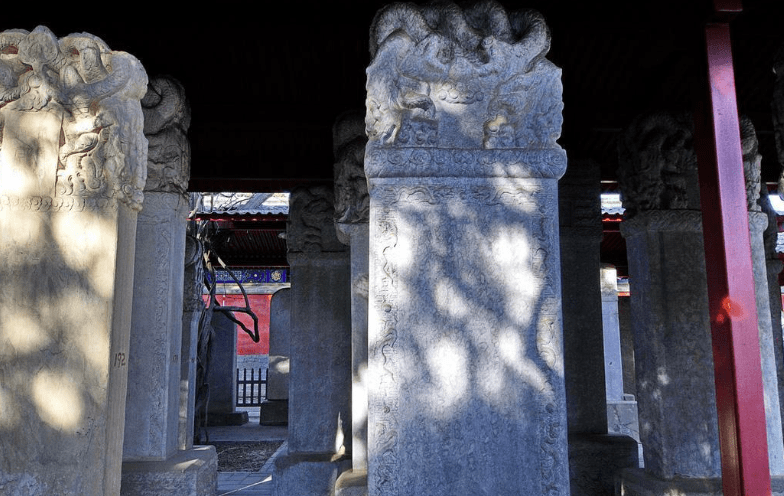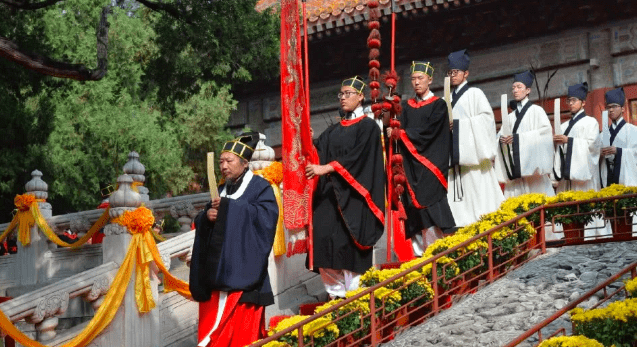
我們是一群來自不同學系的香港大學生。我們成立《清議》,旨在透過各電子平台定期分享我們對公共議題的觀察,涵蓋政治學、公共政策、外交、歷史、文化、法理學、經濟等範疇。以理性對話促進知識交流,重構價值,回應時代的訴求。 💡 Telegram 頻道:https://t.me/civilcritique
[Qing Discussion on China] The Family Temple of the Chinese Nation——The Source of the Rise of Confucianism

Since the Spring and Autumn Period and the Warring States Period, the Confucian culture represented by Confucius has had a profound impact on the traditional Chinese humanistic and moral concepts and even the historical and social development. In the period of Emperor Wu of the Han Dynasty, the thinker Dong Zhongshu carried out the policy of "removing a hundred schools of thought and respecting only Confucianism", which further effectively combined Confucianism with ancient autocratic kingship, and established the orthodox position of Confucianism in China's traditional culture for the next two thousand years.
One of the important symbols of Confucianism is the Temple of Confucius . Throughout the dynasties, rulers have built numerous Confucian temples and schools for Confucius in different regions. Compared with other historical buildings, the Confucian Temple has its unique architectural style and cultural features. Among the many Confucian temple complexes in China, Beijing Confucius Temple is known as the representative building of Chinese Confucian temple culture because of its special geographical location and historical culture. This time, we walked into the Confucian Temple in Beijing. By exploring the humanistic elements contained in the Confucian Temple, we can see how the worship of Confucius and Confucianism has influenced and shaped the traditional Chinese social development and cultural and moral concepts for thousands of years.
Seven hundred years of cultural museum

"Left Temple, Right Study"
The Beijing Confucian Temple was built in the sixth year of Yuan Dade (1302) and completed in the tenth year of Dade (1306). The etiquette of learning" [i] . The construction of the Confucian Temple was mainly to meet the needs of the Yuan Dynasty rulers to maintain their rule and strengthen cultural and political integration. Since the Yuan, Ming and Qing dynasties, the Confucian Temple in Beijing has served as an important place for the ruling class to worship Confucius and develop and consolidate Confucianism [ii] . It is also adjacent to Guozijian Taixue, a place where scholars of all dynasties and dynasties have dreamed of visiting, working and doing learning.
Sacrificial ceremonial place
In addition, since the Yuan, Ming and Qing dynasties, the Confucian Temple in Beijing has been an important sacrificial and ceremonial place for the imperial court. Since the temple was built more than 700 years ago, the rulers of the Yuan, Ming and Qing dynasties have repaired the Beijing Confucian Temple many times to varying degrees, so that the temple's characteristics, architectural style, and various precious cultural relics such as statues, plaques and various documents can be preserved. remain intact [iii] . In addition to the construction of the Confucian Temple, each dynasty also made different additions or deletions to some buildings of the Confucian Temple, adding the architectural and cultural elements of the dynasty. Therefore, the Confucian Temple in Beijing not only contains the different historical and cultural characteristics of the Yuan, Ming and Qing dynasties, but also highlights the importance attached to the Confucian Temple by the rulers of different classes. From this, we can see how Confucianism and the worship of Confucius evolved with the culture of each dynasty.
Today's Beijing Confucian Temple is located in the central area of Beijing. The antique buildings are adjacent to cultural and creative blocks, residential quarters and various hutongs. This ancient temple continues to exert its cultural influence and continues to shape the identity of the Chinese people under the impact of modern elements. .
The formation of the status of Confucianism
In addition to the statues and plaques of Confucius and other representatives of Confucianism, the Beijing Confucius Temple also retains various steles left by the rulers of the Yuan, Ming and Qing dynasties at the Confucius Temple. For example, in the stele pavilion in Dachengmen, a total of 14 imperial memorial monuments of Ming and Qing dynasties were erected, including "Ming Yingzong Jian Taixue Stele" and "Imperial Most Holy Master Confucius Praise Stele", etc., as the Ming and Qing dynasties The monument of the achievements of emperor Wenzhi and martial arts [iv] . Inside and outside the hall are the royal plaques of the nine emperors from Kangxi to Xuantong in the Qing Dynasty. As the central building of the Confucian Temple, the Dacheng Hall is paved with gold bricks and the ceiling is in the shape of a long well.

The high standard of Confucian temple building etiquette reflects the important position of Confucius and Confucianism in Chinese traditional humanistic and moral culture. One of the reasons is that Confucianism can meet the needs of the ancient unified dynasty for maintaining imperial power. In the Spring and Autumn Period and the Warring States Period, countries attacked each other, so what was needed was a theory that could dominate and enrich the country and strengthen the army. As Qin unified the six countries and established a unified dynasty, the society gradually began to stabilize. The ruler needs an ideology that can well maintain his autocratic rule, so that the rule of the great unified dynasty can continue stably and steadily [vi] .
Confucianism emphasizes that the elders and the younger are respectful and orderly, and the society should establish a good order and ethics, and enable everyone to obey the rules, abide by the constraints of etiquette, and not do things that go beyond the norm [vii] . Confucianism just caters to the needs of the rulers of the Great Unification Dynasty to maintain social order and stability. Under the influence of Confucianism, everyone in the society is content with their own duties and fulfills their own responsibilities, thus establishing a large and powerful society. An orderly network of human relations. The so-called three principles of Confucianism are that the ruler is the subject, the father is the son, the husband is the wife, and the five constants are benevolence, righteousness, propriety, wisdom, and trust. It regulates the relationship between the identity and responsibilities of everyone in society, and enables the state and social order to be able to It tends to develop in a stable manner without turmoil [viii] . Therefore, the reason why Confucius and Confucianism are widely admired by the rulers is also that they can be used as powerful tools to maintain the autocratic rule of the ancient unified dynasty.
Secondly, Confucianism can meet the spiritual sustenance and needs of ordinary people in ancient farming society. In the ancient farming society, the relationship between the people was mainly maintained by the village. The nation has strong feelings for the collective and ethnic groups, and has a very strong dependence and nostalgia for the family blood [ix] . Confucianism itself promotes the ideas of "kindness to the people, benevolence to the people, love for things" and "filial piety to fathers and filial piety to brothers and sisters", emphasizing that we should love and respect our relatives, and pay attention to the importance of interpersonal relationships, so it can be adapted to People in ancient society had strong emotional needs for collectives and clans [x] . In addition, as a kind of thinking of joining the WTO, Confucianism emphasizes that "the sky is healthy, and the gentleman is self-improvement", and encourages people to actively work hard to face life and various troubles. In this way, the people can work hard to devote themselves to social production and construction in an inspiring atmosphere, and their concise and positive thinking can make it easier for the peasants to understand, thus making Confucianism more humane. Therefore, Confucianism is in line with the ideological characteristics of the ancient Chinese people, which is one of the reasons why it has been rooted in people's thinking and traditional Chinese culture for thousands of years.
Inheritance of Confucian Spirit

In today's society, Confucianism still has a huge influence on modern Chinese. Confucianism emphasizes the importance of learning and knowledge. "Education without distinction" and "teaching according to one's aptitude." In addition, knowledge has been promoted in modern Chinese society as an important way to get rid of poverty and change destiny, so that today's Chinese society still attaches great importance to knowledge and education. Today's Beijing Confucian Temple is not only a famous tourist attraction, but also an ancestral temple where people worship and pray to bless their academic success. This temple is enduring for a long time, which shows the status of Confucius and Confucianism in traditional Chinese moral thought. In the next article, we will explore how Confucianism has influenced the relationship between the Han and other ethnic groups and shaped the common consciousness of the Chinese nation.
References
[i] Wang Heming, Wang Cheng, Liang Hong. General Theory of Chinese Temples. Shanghai: Shanghai Ancient Books Publishing House, 2016: p. 212
[ii] Tian Guangqing. Theory of Harmony: Confucian Civilization and Contemporary Society [M]. Beijing: China Overseas Chinese Publishing House, 1998.
[iii] The Culture of Ritual and Music in the Architecture of Ming and Qing Dynasties [J]. Jiang Jinzhi, Lu Ping. Oriental Museum. 2007(01)
[iv] Wang Heming, Wang Cheng, Liang Hong. General Theory of Chinese Temples. Shanghai: Shanghai Ancient Books Publishing House, 2016: p. 212
[v] Li Ruizhen, Wang Qian. "On the Construction of the Cultural Form of the Museum: Taking the Ritual and Music Culture of the Confucian Temple in Beijing as an Example", 2019
[vi] On the Modern Value of Ancient Chinese Confucian Thought of Social Harmony [J]. Zhou Jun. Journal of Shenyang Normal University (Social Science Edition). 2007(01)
[vii] The Connotation of Confucius' Thought of Governance by Morality [J]. Zhao Qunfang. Legal System and Society. 2008(30)
[viii] The Philosophical Path and Significance of Modern Interpretation of Confucianism [J]. Jing Haifeng. Chinese Social Sciences. 2005(06)
[ix] Hao Shiyuan. Historical Interaction and Diversity of Chinese Ethnic Groups [M ] / /Lu Xiaoheng. Three Religions and Cross-Strait Integration. Beijing: Economic Management Press, 2003: 29.
[x] On Confucianism and Harmonious Society [J]. Liu Zhaowei. Journal of Shenyang Normal University (Social Science Edition). 2006(01)
Author: Xiong Xianghui
【Qingyi Facebook Page】: https://www.facebook.com/civcrit/

Like my work?
Don't forget to support or like, so I know you are with me..
Comment…